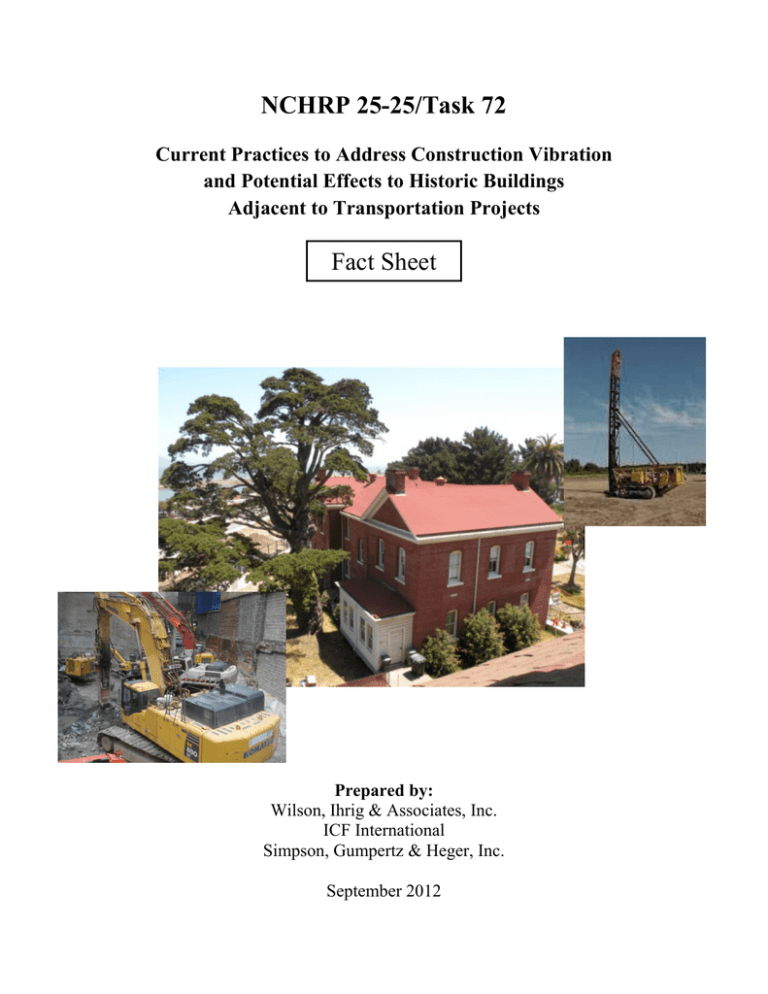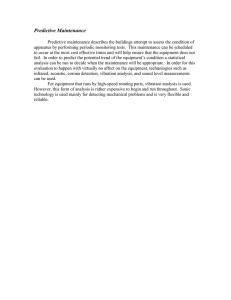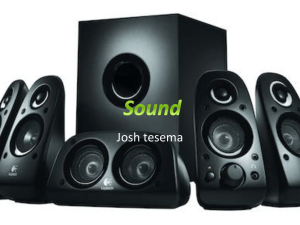NCHRP 25-25/Task 72 Fact Sheet
advertisement

NCHRP 25-25/Task 72 Current Practices to Address Construction Vibration and Potential Effects to Historic Buildings Adjacent to Transportation Projects Fact Sheet Prepared by: Wilson, Ihrig & Associates, Inc. ICF International Simpson, Gumpertz & Heger, Inc. September 2012 Construction Vibration: Heavy construction equipment, particularly equipment used for pile driving and other impact devices such as pavement breakers create substantial ground vibration. Vibration waves travel in the ground outward from the source with diminishing amplitude as distance increases. The velocity of the ground motion is measured in units of inches/sec. The maximum value of motion is referred to as the “peak particle velocity” (PPV). Vibration can be continuous (vibratory roller) or transient (blasting, pile driving). Depending on the amplitude, vibration can range anywhere from imperceptible to annoying and if strong enough can cause damage to buildings. Typical values of PPV from Construction: Equipment Pile driver (impact) Pile drive (sonic/vibratory) Vibratory roller Hoe ram Large bulldozer Caisson drilling Loaded trucks Jackhammer Small bulldozer PPV at 25 feet 0.644 to 1.518 0.170 to 0.734 0.210 0.089 0.089 0.089 0.076 0.035 0.003 Damage Classification Terminology: Cosmetic - The formation of hairline cracks on drywall surfaces or the growth of existing cracks in plaster or drywall surfaces; the formation of hairline cracks in mortar joints of brick/concrete block construction. Minor - The formation of large cracks or loosening and falling of plaster or drywall surfaces, or cracks through bricks/concrete blocks. Major - Damage to structural elements of the building, cracks in support columns, loosening of joints, and splaying of masonry cracks. Susceptibility of Historic Buildings to Vibration: Type of building construction – Older buildings are typically built from more brittle materials (brick masonry, terra cotta, and plaster) when compared to steel and even wood, which are more flexible. Age – Over time the effects of the aging process caused by weathering, temperature variation, freeze-thaw and long-term settlement of the structure weakens building elements decreasing their ability to absorb dynamic loads elastically without sustaining damage. Maintenance – A regular maintenance program that repairs age and weather related deterioration will improve a buildings resistance to exterior vibration. Human Response to Vibration: Human perception of and response to vibration depends on many factors including: o the location of the person (indoors or outdoors), o the presence of distractions such as background noise and, o the level of activity of the person when vibration occurs. For continuous vibration from construction activities such as vibratory compaction or vibratory pile driving, an indoor PPV exceeding 0.035 inches/sec is generally considered to be distinctly perceptible, whereas a PPV of 0.2 inches/sec is definitely annoying. Because transient vibration has a short duration, it requires a higher level than continuous vibration to be perceived. For transient vibration caused by sources such as pile driving and blasting, an indoor PPV between 0.2 inches/sec is considered barely perceptible, whereas a PPV between 2.0 inches/sec would be strongly perceptible. Vibration Criteria for Historic Buildings: There is a wide range of opinion on appropriate vibration limits for historic buildings. At one end of the range is a conservative PPV limit of 0.10 inches/sec except in the case of ancient ruins where 0.08 inches/sec is considered appropriate by some. At the other end of the range, some would consider 0.50 inches/sec to be appropriate or even 2.0 inches/sec. Conservative vibration limits can be set initially with some flexibility in modifying those limits based on detailed engineering investigation and analysis done on a case-by-case basis prior to award of the construction contract. Vibration Monitoring: Monitoring of vibration during construction is one of the best means of protection for buildings. Modern seismographs are small, portable and battery operated. Threshold levels can be used to trigger visual or audio alarms to warn equipment operators and construction engineers when vibration limits are approached.




